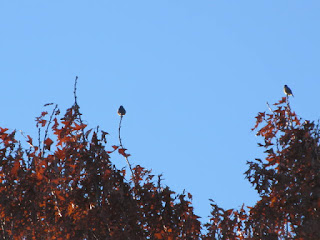Even though I love the warmth - not having to turn on the heat, and being able to walk outside without a jacket, I can't help but feel a little concerned as to the impacts on Nature from a changing climate. She was definitely confused this week with crickets chirping again and ticks out in full force. Thursday morning I found these fresh mushrooms growing on the side of the road - something typically seen in late summer or early fall instead of November.
 |  |
Regardless of the temperature, most of the summer migrant birds have left, and our winter friends have returned. Dark-eye Juncos and Tufted Titmice and Nuthatches are once again plentiful at the feeder. I was surprised on Sunday, though, to see several bluebirds in our front yard. I am told that some bluebirds do over-winter in New Hampshire, but this was the first time that I have seen them during this time of year.
 |  |
Bluebirds sitting in the tree tops this week.
Although the weather has felt like summer, the foliage, or lack thereof, on the trees brings a reality check that it is November. Most of our maple trees are bare, and the deep reds, yellows and bronzes of the oak and beech trees, are fading to brown. However, you can still catch some interesting variety, particularly in the morning and late afternoon sunlight.
 |  |


Finally, I thought I would share a photo of our catalpa tree. It's leaves will be one of the last to fall, and this tree that creates awe when in bloom in the summer, is certainly not going to win any beauty contests this time of year.
 |
| Catalpa - notice the bean pods on some of the brances |
Getting back to the title of this blog - based upon the fact that it is November, and the fact that we have already experienced several mornings below freezing, I would have called this past week Indian Summer. However, according to the Old Farmers Almanac, Indian Summer must occur after November 11th, or St. Martin's Day. Even so, these past few days have seemed like an extension of summer for which I am grateful.
 |
| October 30th Morning Moon |



No comments:
Post a Comment